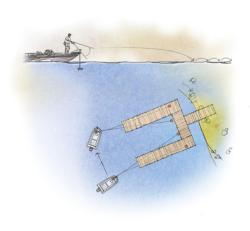Tubes still rock
Once one of the hottest baits, the tube has since been replaced in the minds of many anglers by sleeker, sexier models. But two top tour pros say this classic never lost its luster.
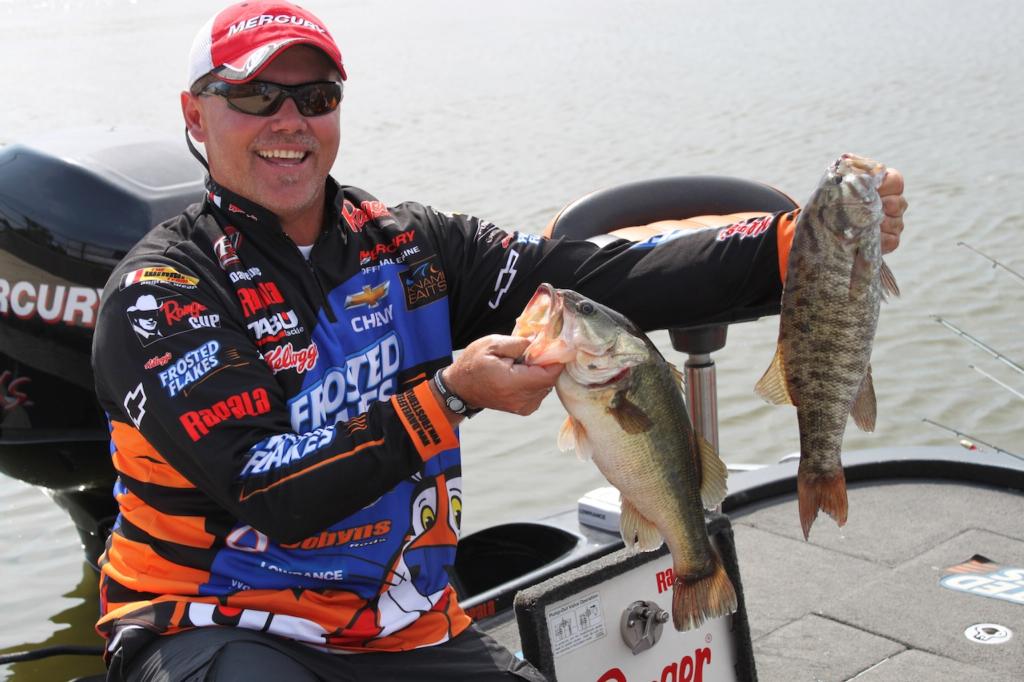
(Editor’s note: The following article appeared in the November/December 2012 issue of FLW Bass Fishing magazine).
Each year, dozens of new soft-plastic lures hit the market, touting unique profiles and fish-catching features. A few become tackle box mainstays, while most just drift off into the past without leaving a big footprint in bass fishing.
Be they big hits or land with a thud, few of the new soft plastics that come along ever garner such a following or develop such a history of effectiveness as the tube. Why? Veteran anglers are quick to identify versatility as the tube’s greatest attribute. It can suggest a baitfish or a crawfish. It can be utilized in power or finesse presentations. It can be rigged a multitude of ways.
So how come so few pros turn to the tube when tournament dollars are on the line? Pringles pro Vic Vatalaro and Kellogg’s Frosted Flakes pro Dave Lefebre believe it’s because pros have given up on this classic in favor of newer models. Many pros prefer to use specialized soft plastics that work only in specific situations, rather than the tube, which can be fit to many situations with careful rigging.
Vatalaro and Lefebre are staunch devotees of the tube. Both achieved much of their early career success finessing and flipping tubes. And according to them, the tube is still a tournament-winning lure throughout the country.
Vatalaro’s Boat Dock System
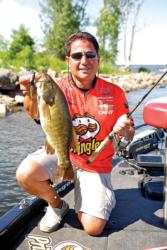 Ever since Kent, Ohio, native Vatalaro made his professional debut, he has relied on his favorite Northern finesse tube tactics throughout the country when the bite has turned tough, such as when bass seek refuge under boat docks in summer.
Ever since Kent, Ohio, native Vatalaro made his professional debut, he has relied on his favorite Northern finesse tube tactics throughout the country when the bite has turned tough, such as when bass seek refuge under boat docks in summer.
The tendency of anglers, as Vatalaro points out, is to skip jigs or work the periphery of the dock with finesse worms and drop-shots. Not Vatalaro. His spinning rod features a downsized version of the tube, which he says is much more versatile than many other dock-skipping lures.
“A small, 3 1/2-inch tube represents what the bass is looking to eat,” says Vatalaro. “Not only does it imitate a minnow, but it also resembles a small bluegill. When on the bottom, it looks like a craw. Other baits simply don’t mimic such a wide variety of the bass’ prey.”
Vatalaro’s favorites are skinny, thin-walled tubes, specifically models made by soft-plastics maker Mizmo.
“There’s not a lot of bulk to them because they are single-dip models,” reveals Vatalaro. “Although heavier tubes are generally easier to skip, the lighter line and spinning gear allow the smaller tubes to travel a great distance.”
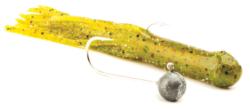 Perfect Presentation – As Vatalaro prepares to skip under a dock, he positions his medium-power spinning rod for an inline pitch-skip, rather than a sidearm toss most anglers favor. The cast looks identical to a conventional pitching motion, but it allows him to execute accurate skips with the finesse tube. The key is to release the line as the tube is traveling parallel with the water.
Perfect Presentation – As Vatalaro prepares to skip under a dock, he positions his medium-power spinning rod for an inline pitch-skip, rather than a sidearm toss most anglers favor. The cast looks identical to a conventional pitching motion, but it allows him to execute accurate skips with the finesse tube. The key is to release the line as the tube is traveling parallel with the water.
He notes that bass, attracted to the commotion overhead, regularly hit the tube on the fall. If fish appear to be finicky, he will lift, drag, hop or even swim the tube shortly after it settles on the bottom.
Tackle Selection – Vatalaro admits that his finesse tube rig is somewhat unorthodox and might seem wimpy for successfully retrieving quality bass from under the far reaches of a boat dock. His system, however, provides two distinct advantages: It does not require a forceful hookset, and the light-line gear facilitates ultra-long casts and skips.
He hand-pours his own 3/16-ounce, light-wire Gamakatsu ball-head jigs with a 90-degree, 2/0 jig-hook. He increases hook size proportionally to weight, up to a maximum 4/0 hook and 5/16-ounce head. The round-head design places the center of gravity forward and creates an arching descent – as opposed to a glide – which elicits more reaction bites because of the faster rate of fall. The light-wire design, on the other hand, proves beneficial when fighting larger bass with light tackle.
“The big advantage to using a light-wire hook is that when a fish pulls that jig into its mouth, it’s hooked,” says Vatalaro. “The fish can’t get rid of it. I don’t even have to set the hook. I just start reeling and give it a pull.”
Pitch-skip under dock and to back walkways.
” border=”1″ align=”right” />If a fish becomes unruly and takes a turn around a dock post, Vatalaro back-reels to allow the fish to run. At the same time, he maneuvers his boat closer to the dock and extends his rod into the water, past the post. After carefully guiding the fish back to the dock and around the post, he leads it to open water.
Lefebre’s Flipping Tube System
Lefebre is rarely found on the water without a flipping stick in hand. Many times, his flipping lure of choice is a tube.
 ” border=”1″ align=”left” />“There are several reasons why I consider the tube a favorite flipping bait,” says Lefebre. “The first and main reason is the ease in which it enters and exits cover, without creating much disturbance. Although it has a bulkier, jig-type of profile, it requires less weight to penetrate cover compared to other baits. And, of all the flipping baits, the tube falls through the water column the fastest.”
” border=”1″ align=”left” />“There are several reasons why I consider the tube a favorite flipping bait,” says Lefebre. “The first and main reason is the ease in which it enters and exits cover, without creating much disturbance. Although it has a bulkier, jig-type of profile, it requires less weight to penetrate cover compared to other baits. And, of all the flipping baits, the tube falls through the water column the fastest.”
Tube-flipping tactics don’t vary much by type of cover. What does vary is the style of rigging. Lefebre shares his advice, along with a couple of techniques designed to get fish to commit when the bite is toughest.
Weight Selection – In thick, matted vegetation, Lefebre rigs a 4-1/2 inch Yamamoto tube with a 3/4-ounce VMC tungsten weight and increases the weight according to the density of the mat. He rigs just enough weight to penetrate the overhead canopy.
If exploring flooded bushes or other gnarly types of brush, he selects his weight depending upon the fall rate that triggers the fish. Most of the time, the required weight is 3/8 ounce or greater.
“Every type of situation is unique,” he says. “You have to figure out whether to soak your bait and convince one to bite, or do just the opposite – fly it through there for a reaction bite. When fish are stubborn and not biting, you have to do one or the other, and experiment a little.”
Tube Rigging – The key to maximizing the tube’s effectiveness in any flipping situation, Lefebre believes, is proper rigging.
“For years, pros have talked about the tube’s enticing, erratic fall. That’s hogwash,” he refutes. “I want my tube to fall straight down. I don’t want it to spiral and twist my line. It only does that if it’s rigged improperly.”
In order to assure a straight fall, Lefebre rigs his tube with a 3/0 or 4/0 Gamakatsu Extra Wide Gap Superline hook, paying close attention so that the hook is aligned with the main axis of the tube and does not create any unnatural body deformations. He also works holes through both walls of the tube where the hook shank intersects the body, so that the hook will penetrate easily. Before finishing the rig by Tex-posing the hook, he carefully bends the hook outward just below the barb until it rests flush with the tube wall. The modification assures that the tube does not dimple or bow from the hook point, and improves hooking percentage. In situations where snagging is not a major concern, Lefebre elects to leave the hook point exposed.
Even armed with the knowledge of proper rigging, Lefebre warns that anglers have to be cognizant of the risk of losing fish when flipping tubes.
“That’s the one downside,” he admits. “Tubes are stiffer than other soft plastics and have two walls, and you cannot use straight-shank hooks to rig them. Those are the things working against you, so you need to set the hook like you are about to yank an 8-pounder out of a mat on Lake Okeechobee. You really have got to give it to them when flipping a tube.”
Regional Results?
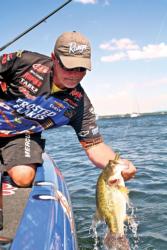
” border=”1″ align=”right” />Lefebre has flipped his tube to several Walmart FLW Tour and EverStart Series top-10s, from Northern tournament venues Lake Champlain and 1000 Islands to the Atchafalaya Basin in the Deep South. Vatalaro has also ridden his finesse tube system to top finishes all across the country. Still, the tube, despite its fame and years of success, remains an unheralded tool on tour. Neither pro minds it that way, however. In their eyes, the tube is “something different” for Southern bass.
“For some reason, it’s still a `Northern thing,'” chuckles Vatalaro. “I use them, Dave uses them and other Northern anglers use them. But, there are so many other anglers that never really use them. I think it is a great technique just for that.”
Stroking Deep Weedlines
Probing deep weedlines with a tube is a technique that Lefebre considers when on the hunt for his next tournament-winning bag.
“It is just a real quick way to cover deep water,” he explains. “Tubes fall fast, and you can hop them real high. It is kind of like stroking a jig, but with plastics. It provides a different look that bass are not accustomed to.”
Lefebre usually starts on the outside edge of the weedbed. He casts roughly parallel to the edge of the weeds and strokes the tube up and down.
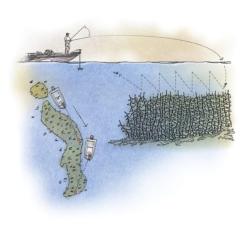
Begin on edge of weedline, but work into middle of weeds if fish aren’t found on edge.
” border=”1″ align=”left” />The goal is to work quickly and search for “patternable features,” such as strips, holes, points and other features that might hold schools in this spot and others like it. But if the edge does not produce, Lefebre moves farther into the weedbed with a more traditional flipping-punching technique.
On Northern fisheries, especially, Lefebre notes that flipping deep weedlines with tubes can yield impressive mixed bags of largemouths and smallmouths.
“I don’t like to take myself out of the smallmouth lottery,” he says. “On lakes like Champlain, 1000 Islands or Chautauqua, smallmouths shy away from worms, creatures and even jigs. They are just too big. But you never know when you might get that lucky bite from a 5-pound smallmouth when fishing a tube. If you put a tube in front of him, he’s going to eat it.”
Lefebre’s Repulsive Tubes
Dave Lefebre is a scientist-gone-mad when it comes to tinkering with his tubes. Never one to use a tube straight out of the package, he modifies shapes, sizes and colors. His goal is to create the ugliest, most repulsive tube in the water. Here are some of his favorite modifications:
• Soak unscented tubes in scented plastic bags.
• Lock tubes into a plastic bag partially filled with water. As a tube absorbs water, it expands in size, changes in texture and reveals imperfections like bumps created during the pouring process.
• Pinch and tear off the bottom 1/4 to 1/2 inch of the tube tentacles. The uneven appearance is especially effective on bedding bass, and this also frees tentacles that are stuck together.
• Fade stock tube colors by placing them in the sun for extended periods of time.
